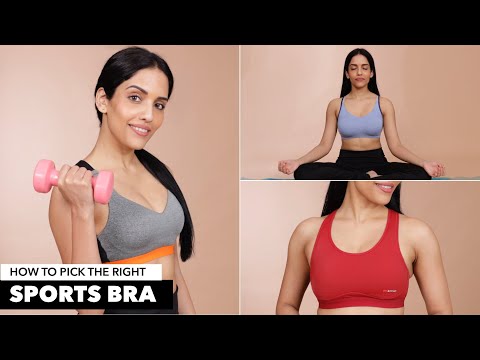What Size Sports Bra Should You Buy?
Contents
Choosing the right sports bra is crucial to your comfort and performance. But with all the different shapes, sizes, and styles out there, how do you know which one to buy? Use this handy guide to find the perfect fit for your next workout.
Checkout this video:
Introduction
It’s no secret that not all bras are created equal. In fact, even within the same brand, there can be a lot of variation in fit, comfort and support. So how do you choose the right sports bra?
Here are a few things to keep in mind:
-Your sports bra should be comfortable and not too tight.
-It should provide support without squishing your breast tissue.
-If you’re larger-busted, look for a sports bra with a wide band and adjustable straps.
-For high-impact activities, look for a sports bra with encapsulation (meaning each breast is held separately) and compression (meaning the breast tissue is compressed against the chest wall).
Below is a general guide to help you choose the right size sports bra:
XS: 30A, 30B, 32A, 32B
S: 34A, 34B, 36A
M: 36B, 38A, 38B
L: 38C, 40B, 40C
XL: 42C, 44C
The 3 main types of sports bras
Buying the right sports bra is extremely important. Not only will it make working out more comfortable, but it can also help prevent injuries. Sports bras come in a variety of sizes, but they can generally be classified into three categories.
Compression sports bras
Compression sports bras are designed to hold your breasts close to your chest and are ideal for low-impact activities. These bras minimize breast movement and are often used by women with smaller busts.
The main advantages of compression sports bras are that they:
-Reduce breast bounce
-Are comfortable
-Are often less expensive than other types of sports bras
-Can be worn as a standalone bra or as a layer under other clothing
Encapsulation sports bras
An encapsulation sports bra offers support to each breast individually and creates a separating effect. This type of sports bra is ideal for women with a cup size A or B. The band should feel snug but not constrictive, the straps should be adjustable, and the cups should encase each breast without spillage.
Combination sports bras
Made with both compression and encapsulation techniques, combination sports bras offer support in all the right places. They’re ideal for high-impact activities, and they come in a variety of styles, including racerback and front-close designs. If you’re looking for a versatile sports bra that will give you the support you need during any activity, a combination style is a great option.
How to measure yourself for a sports bra
Before you can buy the perfect sports bra, you need to take your measurements. You will need to know your bust size and your band size. To measure your bust, you will need to wrap a measuring tape around your back and under your arms. For your band size, you will need to wrap the measuring tape around your torso, right under your bust. Once you have your measurements, you can start shopping for your sports bra.
Step 1: Measure your band size
To measure your band size, stand in front of a mirror and wrap a soft measuring tape around your rib cage, just under your bust. Make sure the tape is level all the way around. Keep the tape snug but not too tight, and round up to the nearest whole number. If you don’t have a soft measuring tape, you can use a string or ribbon and then measure the length with a ruler.
Step 2: Measure your cup size
To find your cup size, you will need to measure the circumference of your chest at the widest point and the circumference of your bust at the fullest point. Once you have these measurements, you can refer to a size chart to find your cup size.
For most women, the difference between these two measurements will be one or two inches. If the difference is less than one inch, you are an “A” cup; if the difference is one inch, you are a “B” cup; if the difference is two inches, you are a “C” cup; and so on.
What size sports bra should you buy?
Sports bras come in a variety of sizes, so it can be confusing to know which size to buy. It is important to find a sports bra that fits well because it will provide support and minimize breast movement. There are a few things you should take into consideration when choosing a sports bra, such as your bust size, cup size, and the type of activity you will be doing.
Use your measurements to find your sports bra size
To find your sports bra size, take a soft measuring tape and stand in front of a mirror. Make sure the tape is level and parallel to the floor all the way around. Then, follow these steps:
1. Bend forward at the waist, scooping your breasts into your hands. With your hand under and your fingers over, measure around the fullest part of each breast—across the nipple and back to where the breast tissue meets your chest. Keep the tape taut but not constricting, and round up to the nearest whole inch
2. To calculate your band size, take that number and add four if you measured an even number, or five if you measured an odd number. So, if you measured 33 inches around, you’d add four for a total band size of 37
3. To calculate your cup size, subtract your band size from your bust measurement. Each inch equals one cup size. So, if your band size was 37 and your bust measurement was 39 inches, that’s two inches—or two cup sizes—which would make you a B cup. (If the difference is just one inch, you’re a Cup A.)
The most important thing to remember when shopping for a sports bra is that comfort comes first. So even if you think you know your size, always try on a few different styles and sizes before making a purchase. And don’t be afraid to ask for help—a good salesperson should be able to assist you in finding the right fit
Find your sports bra size in a store
There are a few ways to determine your sports bra size. The most common (and mostaccurate) is to go to a sporting goods store that specializes in bras and get fitted bya professional.
But if you don’t have time for that or you want to do it yourself, here areinstructions for how to measure yourself at home. Again, this is only a guide –we always recommend being fitted by a professional if possible.
1. Wear a thin, close-fitting tank top or t-shirt and remove any bulky clothing or underwear that will add extra inches to your measurements
2. Using a soft measuring tape, measure around the fullest part of your chest, making sure the tape is level all the way around and parallel to the floor. This is your band size
3. Bend forward at the waist, keeping your back straight and bring the tape measure up over your head and around the fullest part of your chest (usually near your shoulder blades). Make sure the tape measure stays level all the way around. This measurement is called the “over bust” measurement
4. To find your cup size, subtract your band size from your “over bust” measurement
5. Each inch difference represent a cup size— so if there’s a 2 inch difference, you’re a B cup; 3 inches = C cup; 4 inches = D cup; 5 inches = DD/E cup; 6 inches = F/G cup
6. If you don’t have 2 similar measurements, it’s best to go with the larger number (this is especially important for band sizes). Also keep in mind that sports bras tend to run small, so you may want to buy a size up from what you normally wear
A note on plus sizes: Most sports bras come in small, medium, and large, with additional plus sizes (usually XL or XXL) available from some brands. If you fall into this category, it’s important to make sure you find a style designed specifically for plus-size women—these will have different construction than regular styles and offer more support
Conclusion
Now that you know how to measure yourself and what size range you fit into, it’s time to go shopping! Keep in mind that every brand is different and you may need to try on a few different styles before you find one that fits well and provides the support you need. And don’t forget, you can always adjust the straps or band to get a customized fit. Happy shopping!





